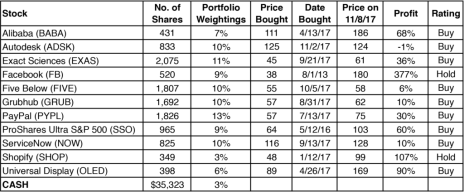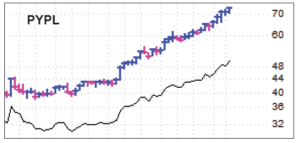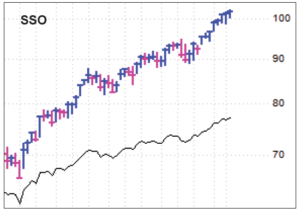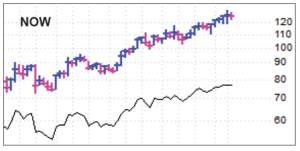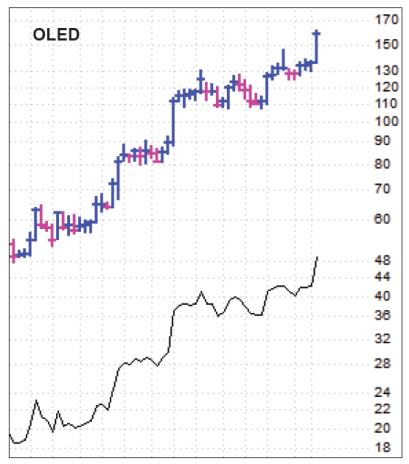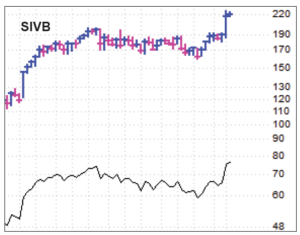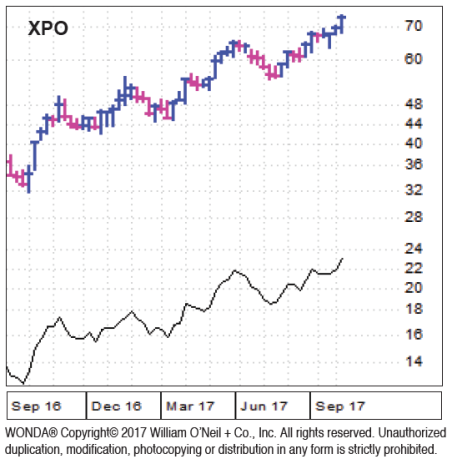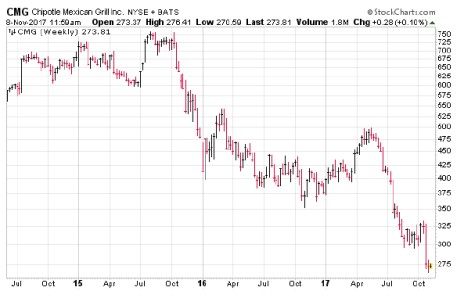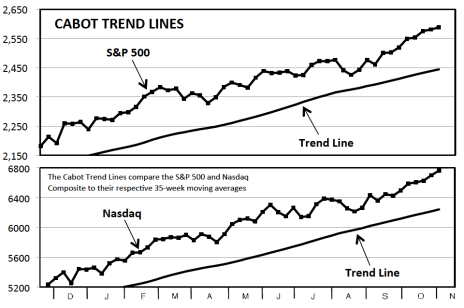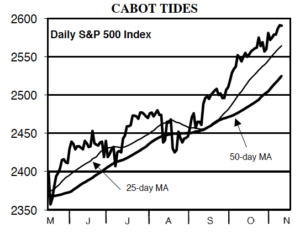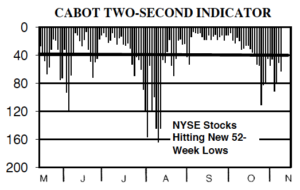There are a few yellow flags out there, from short-term sentiment measures to a weakening broad market (our Two-Second Indicator is again unhealthy), but the trend of the major indexes is firmly up, and the action of growth stocks has been terrific, including a bunch that have surged on earnings in recent weeks.
Cabot Growth Investor 1380
[premium_html_toc post_id="141226"]
Just Because It’s Unusual Doesn’t Mean It’s Wrong
Whether it’s due to a high school math class that taught the meaning of the bell curve or just through observation, most people have a good sense of what’s normal. You don’t see that many Maseratis on the road, for instance, and the Northeast’s recent stretch of 70-degree days (while great!) was definitely out of the ordinary for November. No experts are needed to tell you these are unusual.
In real life, those unusual examples are usually followed quickly by a “reversion to the mean”—the next few cars you see will be Toyotas or Chevys, and our weather will return to a crisp 50 degrees a couple of days later. In other words, we’re all used to things being in the normal range, and even when they’re not, we’re used to things quickly reverting.
But the market doesn’t generally conform to norms, which is one reason it throws so many investors for a loop. For instance, the S&P 500’s average total return from 1928 through 2016 has been 9.5%. Knowing that, most expect the vast majority of years to return between, say, 0% and 20%. Not so! It turns out 54 of those years (61%) either resulted in a loss or a gain of more than 20%. (And, amazingly, just 19% of all years returned between 5% and 15%.) What seems unusual in the market is often normal.
This year has seen many unusual events, with shockingly low volatility (most of the VIX’s lowest readings in history have come this year) and a dearth of pullbacks (the S&P 500 has gone more than two months without a daily drop of 0.5%!) despite a steady stream of worries. But just because it’s unusual doesn’t mean it’s wrong—in fact, as we wrote in the last issue, many studies tell us this recent, unusual strength bodes well for the months ahead.
Obviously, there will be pullbacks and shakeouts, and we’re seeing some signs of complacency along with a broad market that’s weakening. Thus, picking your spots on the buy side and honoring your stops is a must. But with the major indexes and leading growth stocks in strong uptrends, you should remain heavily invested.
[highlight_box]WHAT TO DO NOW: Stay bullish. In the Model Portfolio, we bought Autodesk (ADSK) last week, bringing our cash position down to just 3%. Tonight, we’re also placing Alibaba back on Buy, giving us nine Buy-rated stocks. Details inside.[/highlight_box]
Model Portfolio Update
A year ago, in the wake of the U.S. election, earnings season was brutal for us, as growth stocks of all stripes were blasted and investors rotated into old world, cyclical-type sectors. This earnings season, though, has proven to be nearly a mirror image, as most growth stocks reacted well to their numbers, including a couple of ours that have shot ahead.
With our buy of Autodesk (ADSK) last week, we’re basically fully invested (just 3% in cash), so while we’re keeping our Watch List up to date, most of our focus is on managing our stocks. It’s possible we could take partial profits in a stock or two if they get super extended, and we’re keeping an eye on any names that show signs of stalling out.
But for the most part, doing nothing is usually your best course of action in a bull market, and that’s what we’re doing tonight.
Current Recommendations
BUY—Alibaba (BABA 186)—BABA is going back to Buy as we like the stock’s recent shakeout-and-rally action. Two weeks ago, the stock had dipped below its 50-day line and had made no net progress in more than two months. But it’s since snapped back to new price highs on excellent volume, and the company’s Q3 report was outstanding—sales (up 47%) and earnings (up 63%) both trounced expectations, with all the sub-metrics also looking good. (Its cloud computing division, which is similar to Amazon Web Services, grew another 99% in the quarter.) Analysts didn’t hike their estimates much, but they’re still looking for 24% earnings growth in the December quarter and 31% growth next year. Back to the stock, it’s not a perfect picture (the RP line isn’t yet out to new highs), but we’re putting more emphasis on the good-looking snapback and the stock’s overall uptrend. Hold on if you own some, and if you don’t, you can buy around here with a mental stop in the low 170s.
BUY—Autodesk (ADSK 124)—We added Autodesk to the portfolio last week, and it’s basically marked time in the low 120s since. It’s not going to be the hottest glamour stock, but we believe the firm’s cash flow is set to explode in the years ahead as the firm reaps the benefit of its shift to a cloud- and subscription-based business model. Many big investors are buying in to that idea; Fidelity, for instance, owns about 13% of the company. The stock had an up-and-down consolidation from June through September before marching out to new highs last month. We think you can buy some here. Earnings are due on November 28.
BUY—Exact Sciences (EXAS 61)—EXAS has surged in the wake of another outstanding quarterly report. We wrote about some of the firm’s numbers in last week’s update (sales up 156% and Cologuard tests up 136%, while revenue per test and cost per test both headed in the right direction), but what impresses us just as much are the underlying reasons for that growth. Cologuard’s compliance rate remains much higher than other colon cancer screening methods (66% in the quarter), which has allowed it to attract untapped, younger parts of the market (half of Cologuard users have never been screened before!). Because of that, management has actually upped its long-term forecast, believing it can eventually capture 40% of the market—that would be 32 million tests per year, up from 570,000 this year! Obviously, you can’t hang your hat on such a distant forecast, but it’s clear the potential remains enormous as more and more physicians order it (10,000 new doctors in Q3 alone). The stock is very extended here after a big run (the 50-day line is near 47.5), and a plunge into the high 40s (back toward our average buy price of 46.5) would be a red flag. In fact, we could consider booking partial profits if EXAS continues to go vertical. But we’re not going there yet—the buyers are in control here, so hold on if you’re already in, and if not, you can start a position on a dip into the mid-50s.
HOLD—Facebook (FB 180)—Facebook reported another solid quarter last week, with sales up an incredible 47% (advertising revenues rose 49%) and earnings leaping 77%, both of which were was well north of expectations. Daily active users totaled 1.37 billion, up 16% from a year ago, and, of course, that doesn’t include user totals on Instagram, Messenger or WhatsApp. That said, management again set forth a big spending target for 2018 (up 45% to 60%!); historically, the initial spending guidance has proven to be too high, but that’s a big reason analysts see Facebook’s earnings up just 14% next year. The stock isn’t in bad shape, but the RP line is still basically flat since late July, telling us it’s not a great leader right now. We’ll stay on Hold.
BUY—Five Below (FIVE 58)—There’s not much new to report with Five Below (though it did announce recently that it opened its 600th store), as the stock tests the top of its recent 54 to 58 area. Earnings are likely out at the turn of the month, which will be key, but until proven otherwise, we’re going with the view that FIVE’s strength in September was the beginning of a sustained advance that will be driven by years of foreseeable 20%-plus growth. We’ll stay on Buy.
BUY—Grubhub (GRUB 62)—The stock made us wait nearly three months, but our patience with GRUB has begun to pay off in the wake of its better-than-expected Q3 report. Big investors finally are getting comfortable with the idea that competition isn’t a huge threat to Grubhub, thanks to the company’s dominant position (it’s four times the size of its nearest competitor) and the huge potential from its Eat24 acquisition from Yelp, which will double the firm’s presence in many Tier 2 cities and add thousands of restaurants to its platform. Bottom line: The story, numbers and chart are all in alignment here on the upside. We think you can buy some GRUB here.
BUY—PayPal (PYPL 75)—PYPL remains in a firm uptrend, though there’s no question the stock is extended to the upside, so pullbacks or shakeouts are possible. Still, given that shares broke out of a post-IPO base “just” six months ago, we’re thinking there’s more upside down the road. One thing we’re watching will be news on Venmo, the firm’s increasingly popular peer-to-peer money transfer service ($9.4 billion of volume in Q3, up 93% from a year ago). PayPal is just starting to monetize the platform, allowing users to pay with Venmo at over two million merchants, and while management will go slow, this could end up being an extra avenue of growth in the years ahead. Sit tight if you own some, and if not, try to buy on dips toward the 25-day line (now near 70 and rising).
BUY—ProShares Ultra S&P 500 Fund (SSO 103)—SSO looks fine, but after a smooth, steady uptrend during September and the first half of October, the fund (and the S&P 500) has turned a bit choppy during the past three weeks. We’re not going to overreact to that, but we think this leveraged long fund is a better buy on dips of a couple of points.
BUY—ServiceNow (NOW 128)—NOW had a good-sized initial shakeout on earnings and a quick rebound to its highs in the upper 120s, and it’s since tightened up above its 25-day line. That action is fine with us, and nothing in the recent quarterly report has changed our mind on the firm’s earnings power; one analyst sees free cash flow rising 42% next year and another 36% in 2019, with plenty more beyond that. On the downside, a break of the 115 area would tell us that big investors have some doubts and could have us looking for faster horses. But at this point, we think NOW is offering a solid entry point here.
HOLD—Shopify (SHOP 99)—Shopify the company is doing just fine, as its third-quarter report confirmed, with revenues surging 72%, gross merchandise volume up 69% and other measures (including another record quarter of merchant additions and rapid growth at its lending arm) looking great. However, the company is not the stock, and SHOP likely needs more time to consolidate and come out of the public’s eye following its early October plunge. If you have a loss or no profit, you could consider trimming your position or keeping a tight stop in place. But if you have a small position and a good profit like us, we advise hanging on and using a mental stop in the upper 80s.
BUY—Universal Display (OLED 169)—OLED is once again one of the market’s leading glamour stocks, as the firm’s blowout quarterly report last Thursday raised expectations that the organic light emitting diode boom is accelerating. On its conference call, the company’s top brass presented many bullish data points from big OLED producers, including surging capacity additions at firms like LG and Sony. The iPhone X and other smartphones should remain a big driver, but OLED TV production is also likely to surge as prices come down. Analysts now see earnings of $3.12 per share next year, up from $2.85 before the report and 33% higher than this year, though that could prove to be very conservative if things go right. Chart-wise, OLED is obviously strong, but note that the stock just got going after five months of no progress. Thus, while pullbacks and corrections will come, we think shares have further to run. Hold on if you own some, and if you don’t, try to buy a small position on dips of three or four points.
Watch List
Atlassian (TEAM 53): We’re still watching TEAM, which has begun to follow through from its brief post-earnings pause. Our hesitation is that we already have one cloud software stock (NOW).
Diamondback Energy (FANG 110): Energy stocks have been out of favor forever, but FANG is perched near all-time highs as the group has begun to soar. Production growth is rapid. Read more in Other Stocks of Interest.
Pulte Group (PHM 31): Homebuilders have a history of making big, sustained moves (in both directions). PHM is one of our favorites in the group with big projected earnings growth, excellent sales and order trends, and a strong, uptrending chart.
Other Stocks of Interest
The stocks below may not be followed in Cabot Growth Investor on a regular basis. They’re intended to present you with ideas for additional investment beyond the Model Portfolio. For our current ratings on these stocks, see Updates on Other Stocks of Interest on the subscriber website or email mike@cabotwealth.com.
Diamondback Energy (FANG 110) — With oil prices surging to near two-year highs as political uncertainty dogs Saudi Arabia, oil stocks are enjoying a wave of investor interest. Diamondback is a Midland, Texas-based explorer/driller that specializes in in the Permian Basin of West Texas, where it has decades of experience. The company has some of the lowest development costs in the industry (and, thus, highest well returns) and is actively buying more land to add to its 191,000 net acres. Q3 results showed an outstanding 112% jump in revenue and a 146% hike in earnings, as net production leapt a mind-boggling 89%. Diamondback is planning to add a 10th drilling rig in Q4, but management emphasizes that strategic plans allow for either rapid expansion or shrinking of operations depending on cash flow. Despite a horrid performance from the energy sector, FANG has been up eight weeks in a row and is perched near all-time highs—it could be a leader if the oil patch remains strong.
SVB Financial Group (SIVB 210) — SVB Bank is a Santa Clara, California-based financial outfit that focuses on financing for promising tech startups around the globe. About 40% of loans go to private equity and venture capital firms, with another 26% heading toward software and internet businesses, with the remainder split among private banking accounts, life sciences and healthcare firms and a heady 1% into premium wines. Like all banking stocks, SVB enjoyed a post-election boost, then rested for a few months until a great Q3 earnings news on October 27 gapped SIVB to new highs. This is the growthiest bank you’re likely to find (earnings up 31% this year, estimated to rise 22% next), and with interest rates set to rise again, the future looks bright.
Tronox (TROX 27) — Tronox is a highly specialized Australian chemical company that makes titanium dioxide, an inorganic compound that gives whiteness and brightness to coatings, plastics, papers and other products. Tronox is one of the lowest cost producers in the world, and sells almost two-thirds of its output to the U.S. Tronox has been gradually reducing its losses, and earnings are likely to improve from here and then boom in 2018. TROX etched a deep launching pad from March through August, but October brought a huge-volume buying wave that lifted the stock to new highs. Earnings are due out tonight after the close—a positive reaction would likely mark a solid entry point for this cyclical stock.
XPO Logistics (XPO 74) — XPO Logistics is a great example of how the market sometimes just gets you. We had XPO in the Model Portfolio earlier this year, buying it at 44 in November 2016. We held through three small corrections and the stock reached 65 last summer. But XPO went into a seven-week correction that included a big spike in trading volume on July 20. In August, when our Cabot Tides turned negative, we looked for our weakest stock and found XPO. (We did make a quality 25% profit on the trade.) Since then, though, shares have worked their way back and the story remains terrific, as management is seeing its order book surge and continues to wring out efficiencies to drive free cash flow higher. We don’t regret following our rules; sometimes the market just shakes you out and you have to move on. But if you’re interested, grabbing shares here or on dips should work out.
Identifying New Leadership Using Earnings Gaps
In the book The Perfect Speculator, author Brad Koteshwar wrote about the teachings of a fictional (we think) trader Boyd Hunt. One of our favorite passages is: “It takes time for the market to establish a trend. And it takes time for that trend to be reversed. Everything in the market takes time. Learning takes time. Making gains take time. Even losing big takes time because the market will occasionally offer small crumbs as gains to remove the fear and instill hope, greed and over-confidence.”
This, of course, isn’t how most investors think nowadays. Today we have Breaking News! headlines via social media and 24/7 news channels, and ultra-fast, computer program-driven trading by hedge funds and prop desks. But, despite occasional wild day-to-day action in individual stocks, the quote above remains true: Big moves take time to play out.
On the downside, there are many examples of this even in a bull market. Look at Chipotle Mexican Grill (CMG), which topped out at 759 in August 2015. Sure, the initial round of health scares caused the stock to crash to 400 by January 2016, but the downtrend has continued to play out, with the stock fading to 350 last November, and after a pop back to 500, shares have collapsed to 270 in recent weeks, even as earnings are expected to rebound nicely this year ($6.75 per share, up from $1.32 in 2016) and next ($9.40).
Stocks in long downtrends are “easy” for us to avoid, as we avoid buying names trending lower and cut all losses short. But the lesson here also applies to stocks that rise—big upmoves in leading growth stocks usually play out over nine to 18 months, and occasionally (for a super leader) longer than that.
And during that big move, it’s normal for stocks to have a few 15% to 25% corrections and multi-month periods of no progress. The ability to sit through these tedious periods in bull markets is one of the real secrets to making money in growth stocks.
Universal Display (OLED) is a good example. Shares got off to a great start for us this spring and early summer, but then came plenty of bumpiness. Two and a half months after that June peak, OLED was down 16% and tickling our mental stop. Shares then spiked to 145, but the sellers weren’t done with it, driving it back to 125 in late September and keeping it down for a few more weeks. (We did sell half our shares during that shakeout because the chart looked iffy.)
By late October, OLED had made no net progress for a full 19 weeks, during which time it had three good-sized pullbacks (18%, 16% and 14%). It wasn’t pleasant, but the stock (and the overall market) never broke down or tripped our mental stops, so we gritted our teeth and held on. And now the stock has come alive, ripping to new highs following another outstanding earnings report last week.
(We’re following the same philosophy with our small remaining position in Shopify (SHOP). On a net-net basis, the stock hasn’t gone anywhere since early June and is still trying to shake off the selling pressures from the short-selling attack in early October. But as long as SHOP can hold above long-term support, we’ll give it a chance.)
Obviously, not every time you practice patience will work out. If OLED had been crushed on earnings, I’m sure we would’ve had second thoughts about holding for months without any progress. We saw this a good number of times in 2014 through 2016, when the market was choppy.
But in the long run, capturing a few big winners makes all the difference—it’s hard to make much money if you’re largest gains are just 15% or 20%, especially if your losses are going to average 12% or so (as ours have during the past many years).
Booking partial profits on the way up is fine, and can allow you to make a bit more money during choppy market environments. But it’s important to remember that big moves take time to play out, and during those rallies, the occasional tedious correction or consolidation is normal. So be sure to give most of your shares a chance to run and become the big winners that really make a difference in your total return.
Cabot Market Timing Indicators
The broad market has been acting up again, which is something we’re keeping a close eye on. But we always place most of our emphasis on the trends of the major indexes and the action of leading growth stocks, both of which look fine. Thus, we remain bullish.
Cabot Trend Lines: Bullish
Our Cabot Trend Lines remain in fine shape, with both the S&P 500 (by 5.9%) and Nasdaq Composite (by 8.4%) holding well above their respective 35-week moving averages. Of course, after eight straight up weeks for the S&P (six for the Nasdaq), some cooling off is possible, but until we see these major indexes crack their 35-week lines for two straight weeks, the overall bull market will remain intact.
Cabot Tides: Bullish
Our Cabot Tides are also firmly bullish here, as all five of the major indexes we track (including the S&P 500, daily chart shown here) remain above their lower (50-day) moving averages. We have seen some small divergences crop up in recent days (small caps are lagging, the Nasdaq is leading), but what’s most important is the trend, which is pointed up.
Two-Second Indicator: Healthy
Our Two-Second Indicator continues its on-again, off-again action, with the number of new lows expanding in big way during the past couple of weeks. And this hasn’t been just oddball securities like preferred stocks or baby bonds, but instead many common stocks, too. We’re keeping an eye on it, as a weakening broad market could eventually infect leading stocks, though right now there’s no sign of that.
[premium_html_footer]
Send questions or comments to mike@cabotwealth.com.
Cabot Growth Investor • 176 North Street, Post Office Box 2049, Salem, MA 01970 • www.cabotwealth.com
All Cabot Growth Investor’s buy and sell recommendations are made in issues or updates and posted on the Cabot subscribers’ website. Sell recommendations may also be sent to subscribers as special bulletins via email and the recorded telephone hotline. To calculate the performance of the portfolio, Cabot “buys” and “sells” at the midpoint of the high and low prices of the stock on the day following the recommendation. Cabot’s policy is to sell any stock that shows a loss of 20% in a bull market (15% in a bear market) from our original buy price, calculated using the current closing (not intra-day) price. Subscribers should apply loss limits based on their own personal purchase prices.
Charts show both the stock’s recent trading history and its relative performance (RP) line, which shows you how the stock is performing relative to the S&P 500, a broad-based index. In the ideal case, the stock and its RP line advance in unison. Both tools are key in determining whether to hold or sell.
THE NEXT CABOT GROWTH INVESTOR WILL BE PUBLISHED NOVEMBER 21, 2017
We appreciate your feedback on this issue. Follow the link below to complete our subscriber satisfaction survey: Go to: www.surveymonkey.com/marketlettersurvey
Neither Cabot Wealth Network nor our employees are compensated by the companies we recommend. Sources of information are believed to be reliable, but are in no way guaranteed to be complete or without error. Recommendations, opinions or suggestions are given with the understanding that subscribers acting on the information assume all risks. © Cabot Wealth Network. Copying and/or electronic transmission of this report is a violation of U.S. copyright law. For the protection of our subscribers, if copyright laws are violated, the subscription will be terminated. To subscribe or for information on our privacy policy, call 978-745-5532, visit www.cabotwealth.com or write to support@cabotwealth.com.
[/premium_html_footer]

